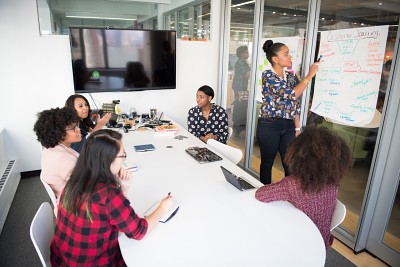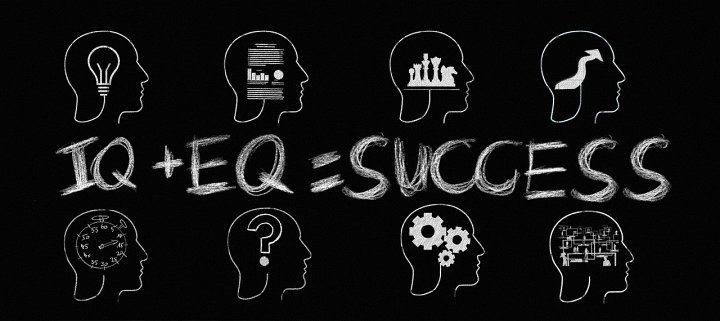Creative Process: Definition, Methods, Obstacles, and How to Achieve it!
You may have heard that creativity is a soft skill of the future of work. Regardless of the area of expertise, professionals are dedicated to knowing their inventive triggers to develop a creative process with methods and tools that activate their creative thinking.
Keeping creativity high in the workplace can be a challenge even for those who think outside the box. Therefore, an excellent creative process is essential for new ideas to emerge with greater frequency and quality.
However, many professionals may struggle to remain creative because they believe this is an innate skill. But what we see is that even creativity has practical methods to stimulate the creative process.
We created the following post to show you simple techniques to help you achieve the creative process every time you desire; please continue reading to find out more!
What is a creative process?
A creative process is a method that aims to create or update specific ideas through a process of gradual evolution.
A creative person is one who, in addition to caring about the interests of others, is also curious, courageous, and does not just think conventionally.
Creative processes are present in the arts, advertising, architecture, and many other areas. In the case of companies, it is no different: creative processes are fundamental to obtain innovative ideas in the corporate environment.
Contrary to what many professionals might imagine, creativity is not a fixed quality available to a few people. In other words, creativity is a skill that, like other skills, can be stimulated, trained, and developed.
According to research Future of Jobs, from the World Economic Forum, creativity will be one of the ten professional skills that will make the eyes of large companies shine in the coming years.
In this way, creative processes emerge to enable creativity through a methodology. Thus, you will have a method that will allow you to have a better direction for creativity.
When someone claims to want to find out how to increase creativity, they are looking for:
- Find a solution to a problem.
- Discover different ways to do the same thing.
- Invent a new use for something that already exists.
- Produce more using less financial, energy, or time resources.
However, putting creativity into practice is not always an easy task. The individual must find an activity that arouses his curiosity so that it arises and flows more easily. Another critical point is to structure the assignment because the person can have creative insights more quickly.
Hence the importance of the creative process, where the individual plans his activities with creativity, effort, and innovation, thus building a product/idea that has some value, both for him and the rest of society.
Let’s look at a simple example:
A designer needs new ideas to create a set of artworks requested by a client. This designer walks through the city streets to get inspired, observing people’s routines and urban landscapes. Ultimately, he returns to his workplace with a set of new ideas he can work on.
Considering this designer’s example, we can say that his walk around the city is part of his creative process. So, we concluded that the designer in question defined his creative process by defining a routine capable of giving him new ideas.
But what exactly constitutes a creative process? What are the main steps that are part of it? Let’s see below one of the most used approaches.

Creative Process: 3 Methods to achieve it
1. Ballas Pillars to Creativity
After understanding how the creative process works, you may ask yourself: but how do I encourage this process?
For Ballas, five pillars help creativity flourish:
A. Acceptance
Ballas argues that it is essential to accept the other, understand that the other is different – and that this is good for the creative process.
When you’re in a brainstorming process, it’s important to welcome all the ideas that come up. And they can drive new creations.
It is crucial to remove the judgment, that voice from the head that judges the other and ourselves.
The presenter also believes in the importance of constantly adapting to the contexts we operate. “If the agency’s budget is low, invent on top of that.”
B. Open-Minded
Ballas believes that we are born creative but often pruned through life with social filters or judgments. This causes us to block some ideas quickly. The “no” must be removed from the creative process, which can be easily recognized when a colleague presents a new idea. We automatically decline it because we have never seen or heard something like it.
C. Improvisation
For Ballas, improvisation is combining things that already exist differently.
We are adaptable human beings, and we can adapt to new situations. More and more, we have to be prepared for this and react to our experiments.
The presenter argues that improvisation also requires planning. This planning can help in the cycle: experimenting, adapting to the results obtained, and experimenting again; this is a way to bring solutions that make a difference and bring innovation.
D. Co-creation
Co-creating means bringing something up together. And Ballas bets that the interaction between people with different backgrounds can potentiate in search for innovative solutions. For him, teamwork only works when everyone is focused and together for real.
2. Abraham Wallas 4
A. Preparation phase
The first phase is the moment of understanding and structuring the central ideas of the idea. It’s time to think about the project’s objective, the best paths to follow, who the target audience is, and what the brand is.
It is an assimilation phase, which prepares the brain with preliminary information about the challenge to be overcome. In simpler terms, it is the stage of studying and researching the idea.
B. Incubation stage
The second stage is precisely the opposite of the previous stage because it is an unconscious stage to assimilate and work on ideas independently in the brain.
It is a part of the process that allows the mind to make more concrete associations with those ideas. Once the concepts have been assimilated, the brain can prioritize activities, and other ideas emerge.
In practical terms, it is a stage where you should take advantage of your leisure time, dedicate yourself to other projects, and do other activities that require other types of stimulation.
C. Lighting phase
It is the third step of the process. It’s not a moment where the light bulb goes on, and the idea comes out of nowhere. This only happens in cartoon scripts.
Look good. It is the third phase of the process. Before that, there was already study and dedication to the project, and you already let your brain assimilate the ideas.
This is when thoughts begin to become more concrete after a thorough study of the information, and ideas become clearer in the head.
D. Implementation and verification phase
A great effect of good ideas is to generate feelings of excitement, enough to put all ideas into practice. But enthusiasm alone does not guarantee the success of the project.
So, this step is the time to put all the questions into practice. It is the most mechanical and operational phase of the entire process.
3. Amabile Principle of Intrinsic Motivation for Creativity
Amabile (1998) developed the Principle of Intrinsic Motivation for Creativity. He argues that creativity is more present in individuals who already feel satisfaction, interest, challenge, and excitement in their work.
According to the author, the creative result (whether it is the solution of a problem, an innovation, a work of art, etc.) can be explained by three components:
A. Expertise
Represents the accumulated knowledge about a given topic (memory, technique, experience, and talent). This means that it is easier to be creative and develop good ideas in fields in which we have mastery.
Therefore, continuous training and constant updating are increasingly important, especially nowadays.
B. Creative thinking
Related to some personal characteristics such as autonomy, independence, self-discipline, willingness to take risks, tolerance for ambiguity and diversity, perseverance in the face of frustrations, and no concern for society’s approval.
According to the author, creativity is associated with a pioneering spirit willing to learn, test, and make mistakes.
C. Intrinsic motivation for the task
It is usually pointed out as the most critical component, as it ends up determining the two previous elements, insofar as the motivation for the task is what will define what will be done.
Directly related to personal interest, pleasure, curiosity, the feeling of challenge, and involvement, motivation is essential for someone to undertake a search for bolder solutions and to take risks.
5 Tips on how to boost creativity in your organization
Below, we have listed some of the main creative process techniques that can be used in companies and an indication of when they are relevant to be used.
1. Brainstorming
Alex Osborn, an American publicist, developed one of the most used techniques for stimulating the creative process in companies from different sectors.
The objective of this tool is to help the production of original solutions simply from two main phases: a) production of ideas and b) evaluation of the proposed ideas. It can be performed individually or in a group; however, in both, one of the basic principles is that there is no judgment or criticism in the first phase.
One of the goals would be to find a solution to a problem, such as determining a new product line, creating a marketing campaign, or even managerial issues such as the areas in which costs can be reduced.
Thus, the production of ideas allows the use of imagination and breaking mental barriers, not seeing any situation as absurd or impossible, so there are no inhibitions.
Although this tool is simple and almost without rules, there are some basic rules, like these:
- There is a definition of the problem and clarification of the focus;
- There is no judgment, no criticism, any idea must be explored;
- Generates as many ideas as possible even if, at first, it may seem ridiculous;
- And supports and encourages all group participants.
The main objective is to produce as many ideas about a particular and necessarily real problem.
2. Method 365 (Brainwriting)
It’s called the silent version of brainstorming; the advantage of this technique compared to brainstorming is that it allows less extroverted individuals to speak up. It can be carried out effectively, there must be at least six people participating.
Group members should sit in a circle with a sheet on which divisions are. In a short time, individuals must register three ideas in the first spaces of the sheet.
Brainwriting makes it possible to have ideas simultaneously and later, in subsequent phases, as the group members are encouraged to develop the ideas generated by the other participants in several rounds without judgment.
After each sheet of paper has been passed to the person sitting next to them three or four times, the session leader collects the documents and reads all the ideas with their additions or writes them on a board for later analysis. In a final step, the group analyzes each of the ideas and evaluates them.
3. Mind Map
A technique that allows you to organize ideas more assertively according to the context of the problem. It contributes so that the information and concepts linked to the central theme are adequately connected.
The elements of this Map are intuitively arranged by the group, according to the importance of the concepts. They are organized into groups (branches or areas) by similarities.
This tool is carried out in a simple way using, preferably, a flipchart sheet, a board, or a tool that allows people to write and visualize what is being written simultaneously.
In the center, synthetically write the central idea, circle it, and work in all directions (radially), then group the radial ideas with a keyword that rescues the content associated with it.
4. Discontinuity Technique
In general, the human being is trapped within his routine, and his mind tends to be blocked. However, when we act differently than usual, we force our minds to face the world differently, which leads us to exercise our creativity.
So, getting out of the routine makes us more creative. An out-of-routine or erratic behavior can be, for example, going another route to work, changing restaurants, etc.
These are usually straightforward things, but they make our brains get out of their comfort zone.
5. Assumption Inversion Technique
Finally, presenting the synthesis of the works of Von Oech (1988). This author presented in his book, A “OCD in the Cuca,” the ten mental blocks that, in his opinion, tie creativity and, consequently, we should be concerned.
A. The right answer
According to the author, an excellent way to block creativity is to think you’ve found the right answer. Why not look for a second correct answer? After all, the answers depend on the questions you ask.
B. This makes no sense
Concrete thinking is critical in the experimental phase. A little fuzzy thinking at the germination stage is very effective when looking for new ideas. The use of metaphors is also an excellent tool to help you think of something different.
C. Follow the rules
Challenging the routine is essential. However, beware of exaggeration; contesting for the sake of doubting makes no sense. Don’t fall in love with ideas. Re-evaluate to leave behind what has become obsolete.
D. Be practical
Practicality is essential; however, the obsession with practicality gets in the creative process. Do not evaluate before creating. Ask “what if” and use the intelligent answers you get as a starting point for new ideas. Encourage others to use the “what if” practice to generate new ideas.
E. Avoid ambiguities
Avoid presenting problems and ideas for solutions to people in a resolved and finished way, as this limits them to thinking like you; the idea is to leave space for others also to reflect and give their opinion.
Cultivate sources of ambiguity that force you to look for more than one way of understanding events and to look for different solutions.
F. It is forbidden to make mistakes
Making mistakes is part of the creative process; mistake 4 is part of learning. The error is allowed in the germinal stage, where ideas blossom in the creation process.
Mistakes are a sign that we are stepping out of our mental models. If we don’t make mistakes from time to time, it is an indication that we are not being very innovative; we are not taking risks.
Mistakes of “action” are welcome, while errors of “omission” can be harmful: think about how many opportunities you might be missing out on by not even trying?
G. Playing is a lacks seriousness
A maxim says that playing is what you learn, and this is 100% true! We should take advantage of playful moments to learn, relax, release a good mood and, above all, create because in the world of make-believe, everything can, and nothing is forbidden.
H. This is not my area
Currently, the line separating one area from the other is very thin. There are no explicit boundaries. The broader and more diversified your knowledge, the more areas you can work in. Try to make analogies in situations.
Currently, teamwork is highly valued. Generally, problems similar to yours have already been resolved in other areas. Also, try to surround yourself with cross-functional teams; creativity does not need to be developed individually.
J. Don’t be silly
Don’t be afraid or ashamed to think differently from the “group” is it you or the others? Is it worth adopting a conformist posture to adapt to group behavior? Is it not worth at least trying to bring about a slight change?
K. I’m not creative
This is undoubtedly the biggest block among the ten presented because when the individual doesn’t believe in his ability to create, innovate and come up with ideas, it’s no use for the organization to encourage him or create a favorable environment.
To be more creative, the first step is to believe in the value of your ideas and have the persistence to keep building on them.

6 Main Obstacles to achieving Creative Process
Daily we are exposed to distractions that prevent our creativity from developing fluidly. Some of these main barriers are:
1. Lack of direction
When you have the moment of enlightenment, you need to have guided goals. Preferably already written with possible ways of acting. Innovation arises when these insights are organized to solve problems.
2. Fear of failure
A significant obstacle in the creative process is the fear of failure. It’s not about the failure itself but about anticipating it. When a negative outcome is feared, the creative process suffers, becoming inefficient and, ironically, more prone to the losses the person fears will occur.
3. Fear of criticism
Professionals want to be accepted by others. This generates the fear of having ideas rejected and criticized; this is a great enemy of creativity, leading to choices that avoid innovation, trying to fit in with safe and underwhelming options.
4. Staying in your comfort zone
Sometimes, valuing consistency can be an obstacle to the creative process. The fear of trying something new limits the professional and keeps him away from being part of an entire innovation process.
5. Passivity
Creative thinking requires proactivity. Without a challenge or something that stimulates the employee, there is no way for creativity to be developed. He needs to be in an environment that challenges the ordinary, the routine.
Therefore, it is necessary to stimulate the brain constantly with new information and ideas.
6. Trying to justify everything
Rationalizing issues, in itself, is something we all do. After all, it is necessary to understand and translate everything that occurs into our context.
However, making every decision accompanied by its “why” can be harmful to the creative process. Having a ready justification prevents the professional from being able to improve in their work environment creatively.
Conclusion
In short, the creative process is a structuring process for the development of innovative activities: from the emergence of the idea to the realization of the project.
In this context, executing a creative process directs efforts to organize thoughts and ideas to put creativity into practice.
Once you know and define your creative process, it becomes much easier to direct efforts to the steps of this process. In the end, you optimize your time and improve your productivity.
Reference and Further Reading
Creativity in the Workplace: 10 Attributes of Innovative Employees. Indeed.








